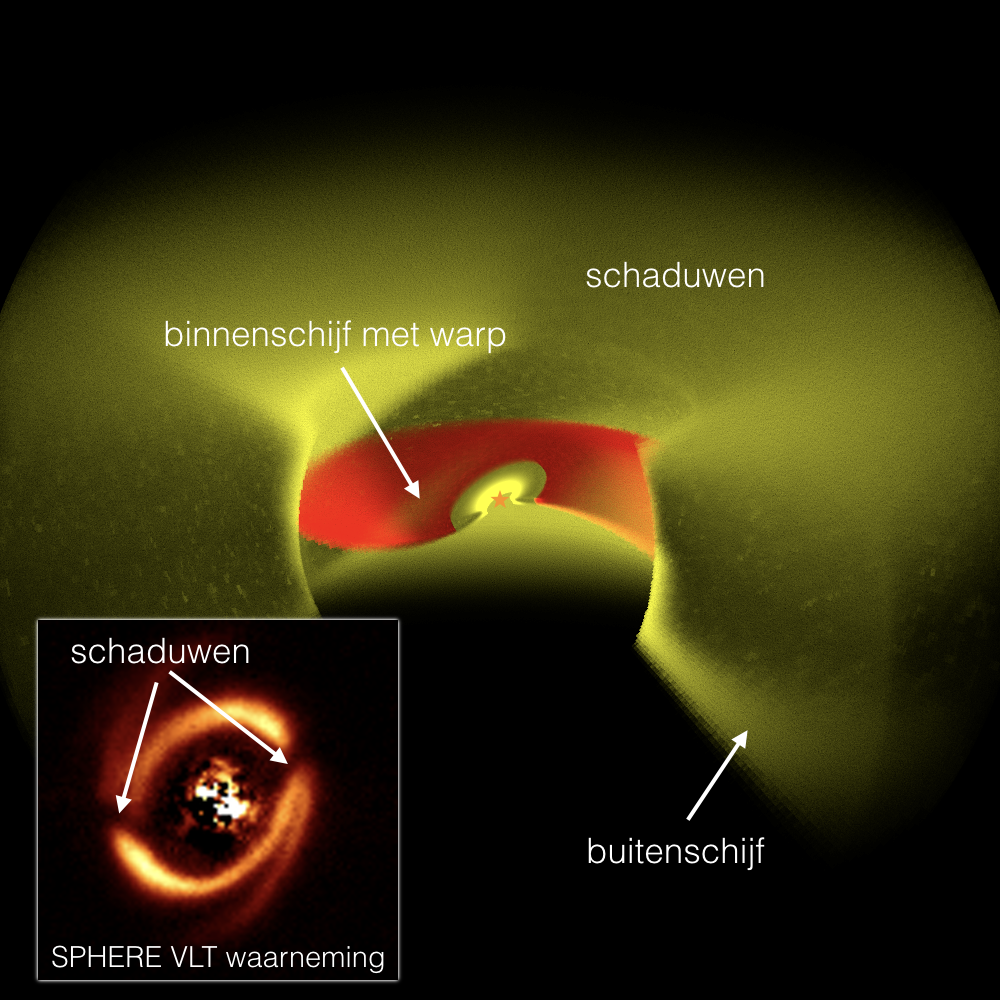Onderzoekers van SRON Netherlands Institute for Space Research in Utrecht en de Universiteit van Amsterdam (UVA) werken aan mogelijke nieuwe manieren om meer te weten te komen over de geboorte van planeten. Ze gebruiken daarvoor het schimmenspel dat zich afspeelt bij een jonge ster.

English follows Dutch
Planeten komen voort uit restanten van het proces waarin sterren worden geboren. Het materiaal voor planeten komt uit afgeplatte schijven met materie die rond jonge sterren draaien. Met huidige telescopen kunnen wetenschappers afbeeldingen van zulke schijven maken met een resolutie als nooit tevoren. Maar inzoomen op het gebied zeer dicht bij de ster blijft voorlopig onhaalbaar, onder meer omdat het licht van de nieuwe ster daar zo fel is dat dat het zicht op kleinere dingen op die plek verblindt.
Wat we van zo vlak bij de ster wel kunnen zien, is het schimmenspel dat de materie projecteert op de grotere structuren rondom de ster. Michiel Min van SRON werkt samen met onder andere collega’s Tomas Stolker en Carsten Dominik van de UVA aan technieken om met gebruik van deze schaduwen de planeetvorming in de omgeving dichtbij de ster gedetailleerder in kaart te brengen.
Deze schaduwen lijken namelijk interessante verrassingen in petto te hebben. Ze verraden bijvoorbeeld krommingen in de schijf, wellicht veroorzaakt door een zwaar object dichtbij de ster, of turbulent veranderende verdikkingen en opborrelende wolken materie. Al deze fascinerende en onverwachts dynamische processen kunnen ons helpen in onze zoektocht naar antwoorden over hoe planetenstelsels ontstaan en wat ten grondslag ligt aan de grote verscheidenheid aan exoplaneten die we vandaag de dag ontdekken.
Zie: Min et al. astro-ph (submitted to A&A), 2017 “Connecting the shadows: probing inner disk geometries using shadows in transitional disks”
Stolker et al. A&A, 2016 “Shadows cast on the transition disk of HD 135344B. Multiwavelength VLT/SPHERE polarimetric differential imaging”
Does shadow play reveal more about planet formation close to a star?
Researchers at SRON Netherlands Institute for Space Research in Utrecht and the University of Amsterdam (UVA) are working on possible new ways of finding out more about the birth of planets. To this end, the researchers are using the shadow play that takes place near a young star.
Planets are formed from the remains of the process in which stars are born. The material for planets comes from flattened discs of matter that rotate around the young stars. With current telescopes, researchers can take images of such discs with an unprecedented resolution. However, it is not yet possible to zoom into the area very close to the star, which is partly because the light from the new star is so bright that it blinds the view of smaller objects at that location.
What we can see so close to the star, however, is the shadow play that the matter projects on the larger structures around the star. Michiel Min of SRON is working together with colleagues Tomas Stolker and Carsten Dominik of the University of Amsterdam and others on techniques that make use of these shadows to provide a more detailed description of planet formation in the environment close to the star.
These shadows appear to have interesting surprises in store. For example, they reveal curvatures in the disk, which may be caused by a heavy object close to the star, or turbulent fluctuating densities and bubbling clouds of matter. All of these fascinating and unexpectedly dynamic processes can help us in our search for answers to how planetary systems evolve and what lies at the basis of the considerable diversity in exoplanets that we are currently discovering.
See: Min et al. astro-ph (submitted to A&A), 2017 “Connecting the shadows: probing inner disk geometries using shadows in transitional disks”
Stolker et al. A&A, 2016 “Shadows cast on the transition disk of HD 135344B. Multiwavelength VLT/SPHERE polarimetric differential imaging”


